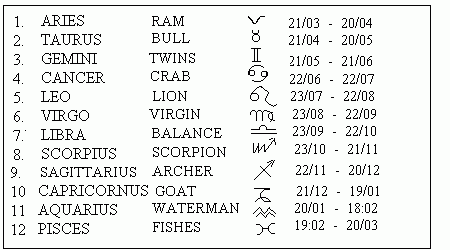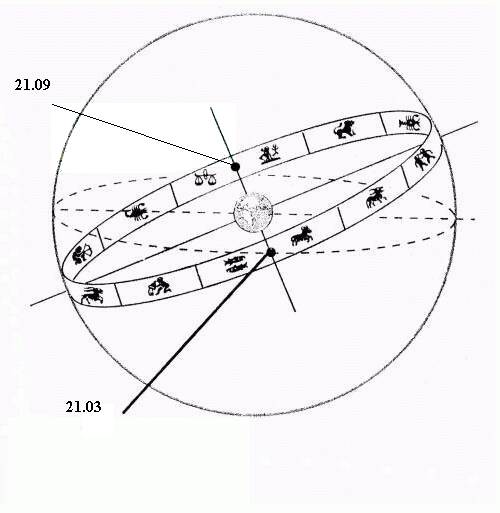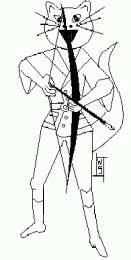| The basis for Astronomy (and Astrology) was created
in the library of Alexandria. It was the largest library
of its time and held approximately 700.000 works (parchments)
. Euclide (306 - 283 BC) wrote his books about geometry
in this library, where there was also an observatory. It
was destroyed several times : in 269 AD by Roman soldiers
and in 390 AD by the Christians. The Greek, who ruled the entire Middle Eastern region, had gathered all the elements of Astronomy and Astrology, in Egypt and Babylon, and put them together in Alexandria. The first Astronomers lived in Mesopotamia, where they noticed that some large stars (Sirius, for example) appeared and disappeared on a regular basis. They also noticed that this coincided with the beginning and the end of summer and winter: the summer EQUINOX and the winter EQUINOX (when day and night are of equal length) marked the length of summer and winter. There were only two seasons. In Egypt, where the rise in the water level of the Nile was vital and was also the time for sowing and harvesting, they chose 36 very bright stars. Each one represented a period of 10 days, for a total of about a year (to within 5 days). It was later changed to 12 months of 30 days each. The large stars that were known were added to other groups of stars to create Constellations. So that they would be easy to remember, they were given a name - usually of a common animal. Those names changed with te passing time : a "Field worker" became "Ram" (Aries). At the beginning there were only 4 Constellations, then 6 and finally 12. To manage to get to 12 the "Scorpio's" pinces had to be "cut" in order to create the "LIBRA" Constellation. So it is in the library of Alexandria - where all that knowledge was put together - that the final shape of the Zodiac was perfected. Zodiac is the Greek word for "Image". This is also where the known planets were named after a Greek god (see the chapter "Planets") and the division into 12 Houses was perfected. We cannot forget that the Arabs continued their research in Astronomy while the Catholic Church prohibited any scientific study during the first 15 centuries of our era, hence the many stars with an Arab name. In other words, the Zodiac that is used today has existed for over 2000 years. It is called "Tropical Zodiac" in which the Sun was in the Aries Constellation during the spring equinox. |
|
| The outer ring
shows the constellations symbols. The Zodiac is divided in 12 equal parts of 30 degrees each. In reality, each constellation's size is different. Some constellations even cover part of another one because despite what the graph would have us believe, they are not located on a precise line. It is impossible to define the boundaries between two constellations. To pretend that a planet is located in a specific constellation is, in most cases, incorrect. See the graph below. The Zodiac was also used by night-time navigators because the Polar star was not located where it is today. Navigation has always worked with 13 sign instead of 12 : it takes into account the "OPHIUCUS" sign (Serpentarius) which is between "SCORPIUS" (Scorpio) and "SAGITTARIUS". |
|
EARTH'S THREE MAIN ROTATIONS AND THEIR INFLUENCE ON THE ZODIAC : |
|
| The Earth's three main rotations cause seeming
rotations of the Zodiac, i.e. : 1. The Earth rotation
around the Sun over a one-year period and this causes the
seeming traverse of the 12 zodiacal constellations. This
movement lasts approximately one month per constellation
(see graph above) and determines the birth sign. 2. The Earth rotation around its own axis over a 24-hours
period and thus causes the seeming traverse of the 12
zodiacal constellations. This movement lasts
approximately 2 hours per sign and determines the
Ascendant. The Ascendant is a very important sign and
will greatly influence the Astrologer's judgement. See
"Dangers of Astrology". 3. The Earth's axis itself also rotates and causes the very slow shifting of the constellations at the rate of 1 degree every 70 years. This is called "PRECESSION". As such, the seeming traverse of a constellation (30 degrees) lasts approximately 2100 years, and a compleet rotation lasts 25.200 years. Because of this, the VERNAL POINT was located in ARIES 2.000 years ago and is actually located in PISCES or AQUARIUS. The constellation where the Sun is located at birth becomes the person's "sign". In reality this is incorrect because of Precession. Over the last 2.000 years, all the signs shifted 30 degrees. So a "Cancer" really is a "Gemini", and the "Gemini" becomes "Taurus". We all know of the "Tropic of Cancer" and "Tropic of Capricorn". These names are no longer correct : we should really say "Tropic of Gemini" and "Tropic of Sagittarius". The Zodiac that takes this reality into account is called a "SIDEREAL ZODIAC". As an example, we can take a major event that happened on May 5, 2002. On that day, there was a Conjonction between the planets MARS, NEPTUNE, VENUS and SATURN in the "GEMINI" sign, and JUPITER in "CANCER". In reality, the first four planets were located in the "TAURUS" sign and JUPITER was in "GEMINI". On the sky map (left) we see precisely that everything has shifted approximately 30 degrees. The Astrologers consider this Conjonction to be "exceptional" and this is true, because it only happens once every 30 years or so. But because these planets are millions of kilometers away from the Earth, and from each other their influence on the Earth is NIL ! |
|




